
|   |

|   |
Gita Govinda in four dance styles through Kavyarasa - Manasi Pandya Raghunandan e-mail: manasi.raghunandan@gmail.com Photos: Abhijit Madhukar & Hemanth Shriyan May 29, 2015 Bengaluru is surely emerging as a city of classical dance festivals in plenitude and amongst the variety that can be seen, Odissi dancer Madhulita Mohapatra, director of Nrityantar, is also putting in loads of efforts to bring out themed festivals and present quality artists. Kavyarasa staged on May 17, 2015 at Seva Sadan, featured soloists presenting ashtapadis from Gita Govinda of Jayadeva which showcased eight dancers from Bangalore including Anuradha Vikranth (prabandha 3, Bharatanatyam), Manasa Joshi (prabandha 4, Kathak), Shama Krishna (prabandha 5, Kuchipudi), Meghana Das (prabandha 6, Odissi), Prateeksha Kashi (prabandha 17, Kuchipudi), Madhulita Mohapatra (prabandha 18, Odissi), Sathyanarayana Raju (prabandha19, Bharatanatyam), Sharmila Mukerjee (prabandha 24, Odissi). It was good to see that the stage was also aesthetically set, with beautiful white scented flowers highlighting the border of the stage. Further, hanging from the ceiling towards the backdrop on the stage were six lamps and a centred single bell that created a serene ambience. Most appealing was the two feet high Krishna -Radha idol on the left side of the stage which added an extra point to the decor. It was delightful to see many rasikas come to witness the program but unfortunately it got too crowded and several fumbled towards the tiered seats in despair. Despite this, the audience appreciated the presentation but the hosts should look into planning with a better alternative next time. The evening opened with the performance of the 3rd ashtapadi “Lalitha Lavanga”, “Viharati Haririha” presented by Anuradha Vikranth. She wore a smiling face from the time of her entry and was involved with the meaning of the lyrics in her every move. She did justice in showcasing how it is springtime, and during “Sarasa Vasanta nṛtyati yuvati” brought out what was expected from this piece. Her footwork was neat and strong and added to the mukhajaabhinaya. From Natya Shastra, took Samotsarita Mattalli of the sixteen bhumi charis towards the zenith of the ashtapadi. She beautifully took a tinge of the handuras imagining Krishna towards the climax while exiting. Using good body language and apt gestures in the frame of Bharatanatyam, Anuradha artistically portrayed on how Radha, beautiful and delicate, looked like a vasanti flower in Spring season as she pined in love for her Krishna. Depicting such a theme, the artist could have chosen a more appropriate colour of the costume to do further justice to the aharya abhinaya that goes with the meaning and lyrics of the presentation, especially while portraying sringara rasa, having some shades of vipralambha. This presentation was set to raga Vasant and talamalika. 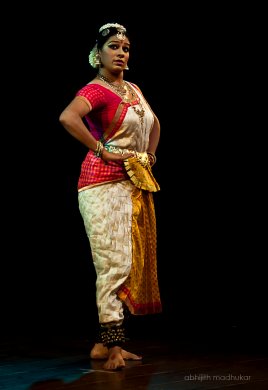 Anuradha Vikrant 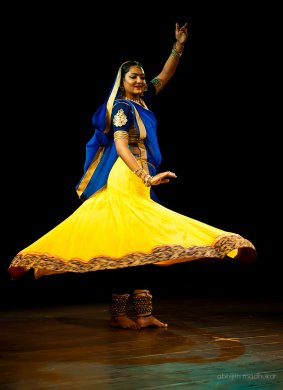 Manasa Joshi Next, an agile Manasa Joshi dressed in a yellow with blue of the Kathak (Jaipur gharana) costume embarked upon the stage. With the lilting voice of Ganesh Desai and the befitting choreography by Nandini Mehta, Manasa presented “Chandana charchita”, “hariri ha mughdha”. She was geared up right from the beginning to use the stage well. In the sanchari bhava, she did justice to the typical Kathak grammar also charmingly showcasing the matki, ghunghat and the pichkaari. Her hastak was well defined and she swiftly moved to the doon from karatala tala. However, she could have done a little more justice to the raas. This presentation was closely structured like a typical gat nikas and also had few shades of lari and tihai. Towards the climax she also used a (16 spins) chakradhar toda. The third soloist was Shama Krishna with “sanchara dadhara”, “raase harimiha” an extraordinary choreography by Guru Vempati Chinna Satyam and trained under the tutelage of Veena Murthy Vijay. She projected a pragalbha and did justice to Radha in vasakasajjika lilting with the shringara. She used a dolapada from akasi chari after sanchari when the sthayee later returns. She beautifully projected the essence of this ashtapadi in the sanchari. The artist was seen doing lip sync at several places which could have been avoided for the better. 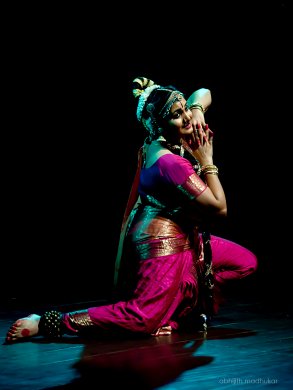 Shama Krishna  Meghana Das Next was “Sakhi he”, “nibhṛta-nikunja” in Odissi by Meghana Das. With a posture in the centre of the stage, trying to follow the lilting music of the flute, she commenced her piece. With neat chaukas and tribhangas and clean postures as well as picturesque hastabhinaya, it was evident that the artist has received good training from her teachers and seems to be a promising soloist of the future. However, for an intense piece like “Sakhi he”, it is very important to feel the abhinaya from the beginning and get more involved. She tried representing the vasaksajja nayika through a madhya. She also used utspandita from the bhumi chari of Natya Sastra over a “Sakhi he.” This piece was choreographed by Sahana Dash and the music was composed by Vinod Panda. Prateeksha Kashi has excellent understanding of abhinaya and controlled body language as well as grace. She brought the poetry to life and sketched the character of Radha in vipralabdha and then khandita nayika. She used her upangas carefully and brought out the shades of anger and ambivalence. She could also project from vikshipta to mudha to niruddha towards the end. She gave an apt portrayal of the storyline of “Yahi Madhava yahi Kesava”, “Rajani janita” under the frame of pragalbha. This choreography was taught to her by her mother/guru Vyjayanthi Kashi. 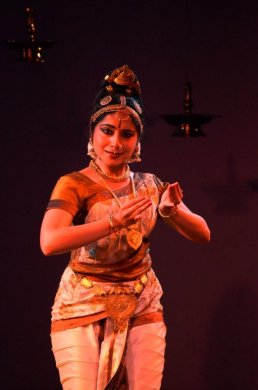 Prateeksha Kashi 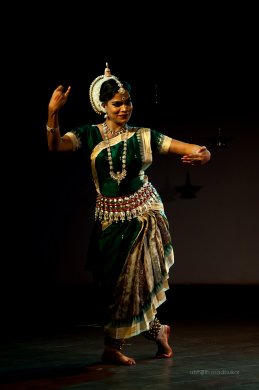 Madhulita Mohapatra Bringing the charm of Odissi, came Madhulita Mohapatra, draped in dark green with cream traditional Odissi costume with a left wing reverse entry, brilliantly choreographed by Aruna Mohanty. In “Madhave ma kuru manini manamaye”, Radha, the kalahantarita, is persuaded by the sakhi evocatively to shed her arrogant pride and meet Krishna. With her neat prushta dhanus and kunchita padas, angasuddhi and bhangis twined with supple torso movement, Madhulita brought the sakhi, the poet Jayadeva (the sutradhara), Radha and Krishna, Vishnu (Dasavatar) prominently visible on stage. Her finesse could be sharply marked when at the climax, she expresses in bhakti, the adbhuta rasa as if seeing the Dasavatar in front of her eyes, by wisely using the upangas that the viewers could stay amazed and focused in comprehension. The only male dancer of the evening and the only one to have 2 accompanists to his live music on flute, Mahesh Swamy and on the vocal Karthik Hebbar was the Bharatanatyam dancer Sathyanarayana Raju, who aptly chose “Priye charushile”, “Vadaasi yadi”. He could bring out the vakrokti of such an intense situation through his profound abhinaya especially during smara-garala-khaṇḍanaṃ. He could briskly project the reaction of Radha (in kalahantarita) towards Krishna’s act of convincing and pleading and did justice in bringing out the meaning of the lyrics. He evoked laughter as he portrayed Krishna dressing Radha like him and further giving Radha his flute to keep but not to play and then when she still goes on to play, it miserably fails. Overall, the Shatha and then the Drishta were clearly seen in his performance which proves his experience on stage. However, after taking this piece to an extent of bliss, he could have omitted the unnecessary showcasing of Krishna (in a no-lyric sanchari) indicating to gopis to move away quietly as Radha is finally convinced and so to see him later. Also, at few places, though the vocalist’s voice was apt for the dancer, going too much into a loud pitch, very close to the mike, could have been avoided, as it was a closed auditorium and drowned the other instruments 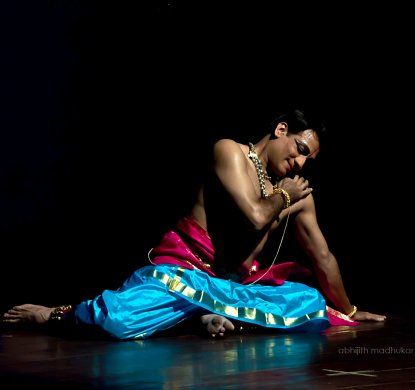 Sathyanarayana Raju 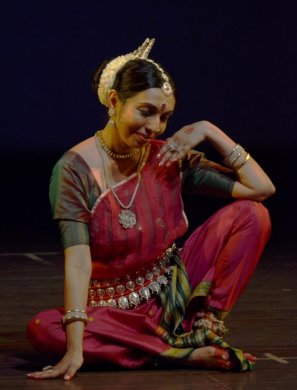 Sharmila Mukerjee The last performer of the day, Sharmila Mukerjee with her elegance and grace, and of course her command over the style and the technicalities gave a mature touch to the piece, and the needed level of refinement as she presented the twenty-fourth ashtapadi “Kuru Yadunandhana” , “Nijagada sa”. She sketched the character of Radha as a pragalbha through her performance. This presentation was in raga Misra and tala jati. It was a choreography of Guru Kelucharan Mohapatra. She presented a strong Svadhinabhartruka on finally having Krishna in subjection and presents herself being loved by him and tries to take control. Krishna too is subjugated by her intense love and pleasing qualities. Her presentation had an unusual choreography crafted with sitting positions in the former part of the piece blending very well with the theme. She was focused in her abhinaya in baddha konasana, bhadravajrasana and sukhasana in the character and in ekagra. Post the performances, in the stage ceremony, the guests Bharatanatyam Guru B. Bhanumathi, artistic director - Nrithyakalamandiram, Kuchipudi Guru Veena Murthy Vijay, artistic director - Sri Rajarajeshwari Kala Niketan, T.G. Narasimha Moorthy, Registrar, Karnataka Sangeeth Nrithya Akademi and N. Chandrashekhar, Deputy Director General, Doordarshan, appreciated the staging of Kavyarasa and congratulated the artists. It was also very thoughtful of the host that in the stage ceremony for the felicitations of the artists instead of the usual formalities, the theme related artistic patachitra and a peacock feather were awarded. Anjali, a student volunteer of the host institution was the compere of the program. Manasi Pandya Raghunandan is an Odissi and Bharatanatyam artist, born in Vadodara and settled in Bengaluru. She is also trained in few aspects of Natya Shastra and traditional folk dances of India and has a passion for writing. She is the director of Abhivyakti, Bengaluru. Notes: Ekagra: Not perplexed Handuras: A moment in dance where the partners cross the hands and hold each other's palms, facing each other and taking turns. Lari: a footwork composition consisting of variations on a theme, and ending in a Tihai. Prabandha: ("Gita Govinda" is a lyrical poetry in twelve chapters, sub-divided into twenty four divisions called prabandha. The prabandhas contain couplets grouped into eights, called ashtapadis) Pragalbha: The Nayika bheda describes 8 kinds which is further categorized into 3. pragalbha is one of the 3 who is mature in the art of love. (This Pragalbha Nayika is further classified as the Dheera, the Adheera, the Dheeraadheera, the sweeya, the Parakeeya, the Samanya, the Jyeshta, the Kanishta). Shatha, Drishta: Just the way there is Nayika bheda, there is also the Nayaka bheda. The moods and emotions of the hero are also classified into different types. Shatha - The deceitful one. eg. Lord Krishna Drishta - When rejected, pleads to be accepted by his woman Upangas: According to Abhinaya Darpana, eyes, eye-brows, eyeballs, cheeks, nose, jaw, lips, teeth, tongue, chin, and face are also called upangas. Thus, upangas in the head are twelve. The other is ankles, toes and fingers. As mentioned in the Natya Shastra Upanga is only six. Utspandita: It is a noun. Name of one of the charis from bhumi chari category explained in Natya Shastra. Vakrokti: Etymologically, the word Vakrokti consists of two components - ‘vakra’ and ‘ukti.’ The first component means ‘crooked, indirect or unique’ and the second means ‘poetic expression or speech.’ Vikshipta, mudha, niruddha: In the Mudha state, the mind is dull and forgetful. Vikshipta is the gathering mind. It is occasionally steady and at other times distracted. The mind is under control in the Niruddha state. |